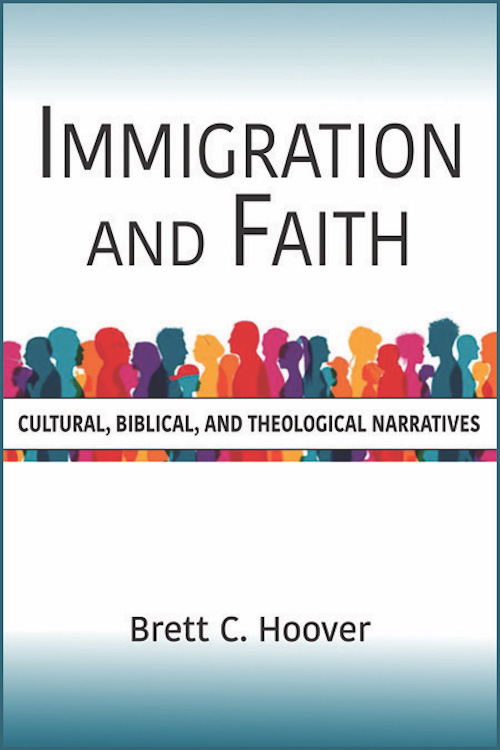
People in New York City are seen during a naturalization ceremony Sept. 17, 2021. (CNS/Reuters/Shannon Stapleton)

As a second-generation Latina Catholic, I find myself skeptical of takes on immigration in faith spaces. They are too often trying to prove a political point, or dramatized and watered down to provide a feel-good story. But I was pleasantly surprised by Immigration and Faith: Cultural, Biblical, and Theological Narratives, written by Brett Hoover.
Hoover looks at immigration as a theme that can be examined from endless vantage points: the immigrant or immigrants, the children or descendants of immigrants, the receiving community, the sending community, those for more open immigration policies, those wanting to limit immigration, and everyone in between.
Whether looking at immigration from a secular point of view or with Abrahamic religious overtones, the reality is that in the United States one's worldview can drastically shape attitudes, assumptions and beliefs about immigration. Many do not take the time to interrogate what they believe and why they believe it; all the while, at the center are immigrants who are ordinary people struggling with the mundane complexity of simply being human.
Hoover offers a primer to the topic that invites the reader to think past political parties and religious affiliation. In Immigration and Faith, there is no exemplary story to offer the "right way" to immigrate or to create an overly spiritualized vignette of salvation and redemption. Rather, the book is broken up into four sections addressing theological, political, historical and cultural viewpoints on immigration without making the immigrant a caricature or role to be fulfilled.
Advertisement
The first section of the book places the reader in the tension of "immigration amnesia" and "immigration nostalgia," and how survival tactics for immigrant families and communities shape the perceptions of later generations.
One such tactic that is explored is assimilation, which is the adopting of cultural practices or norms of a dominant culture. This results in the loss, whether intentionally or not, of important cultural or religious practices or beliefs.
Hoover offers this glimpse into one of the most confounding realities many first and second-generation immigrants navigate in conversations about immigration. When you grow up as first or second generation in the United States, the nuance and complexity of migration is something you realize most people have lost touch with, despite the fact that a majority of those currently residing in the United States are not native to the land that they inhabit.
For example, family origin stories are shared and repeated in a favorable light with key historical and socioeconomic factors falling away over time. Hoover leads the reader to question what effect this may have on U.S. rhetoric around immigration: If society did a better job recognizing the effects of remembering versus forgetting through assimilation, how could that shape a more empathetic route to immigration policy and practice? How does the disconnection from historical and cultural markers, like sociopolitical global events, impact the ability to make common sense laws?

Migrants at a camp near the banks of the Rio Bravo in Ciudad Juárez, Mexico, make a large banner in the likeness of the U.S. flag Oct. 30, 2022. (CNS/Reuters/Jose Luis Gonzalez)
The second section of the book is a sociological look at immigration, focusing in on how those in receiving and sending communities perceive motivation and aspiration for migration.
Hoover points out that concepts like the "American dream" and a "search for a better life" are generalized narratives held mostly by the receiving community, whereas those left behind in sending communities don't always see the worth of the risk or necessity of the arduous journey or uncertain economic prospects.
This dichotomy uncovers another tension between the perception of the receiving community and the sending community — a tension that immigrants find themselves suspended between. The reader is reminded that migrants are not a monolith, but rather individuals coming from unique experiences, cultures, homes and families that all impact the decision to migrate in different ways.
This study of cultural understanding of migration segues into the third and fourth sections of the book, which overtly explore the theological themes of migration and immigration. How does reading of Scripture and understanding of biblical history impact views on migration?
In the last two sections of the book, the reader is challenged to think about how the theological framing of immigration layers morality over the current conversation about immigration today. What are the determining factors of what is right and just in the treatment of migrants, the fairness of policies and laws, and what constitutes acceptable and prudent reasons for migrating in the first place?
Hoover explores how one's reading of biblical texts, or understanding of Jesus' words on hospitality, or the Gospels' narratives about "the stranger" can influence the understanding of a collective responsibility to migrants.
Ultimately, this ends with the Catholic teachings around encounter and conversion, and a reminder from Hoover that the best way to become informed on any topic is in proximity.
By spending time hearing stories of migrants and experiencing the spaces of immigration journeys, one is hard-pressed to ignore the dignity of each migrant as a human made in the image and likeness of God. But what does that ultimately mean for the laws, policies and practices that dictate the lives of those looking to migrate?
Immigration and Faith shines when Hoover explores complicated topics in a way that is welcoming and inviting to those that may not intimately know the reality of immigration today. Hoover, whose skill as a professor is clear, offers digestible reflections and studies on topics that are often hard to articulate, but are a lived reality for those living under the complexity of immigration law or in a mixed-status family.
This book has the potential to lift the burden of proof from the immigrant to the reader, a welcomed shift in a world where immigrants are left in the shadows silently dealing with workplace abuse, wage theft, lack of resources to meet basic needs, and dangerous living conditions while holding the backbone of some of the country's biggest economies.
Like any good teacher, Hoover does not spoon-feed the reader a buttoned-up resolution, but instead leaves the reader wondering, "Where do we go from here?"
Faith spaces could benefit from more studies of these hot-button issues that encourage the reader to think critically about a topic from multiple angles, like Immigration and Faith does, rather than water down stories to a Chicken Soup for the Soul-esque chapter or a crude political statement. Hoover trusts his readers to become students who can arrive at well thought-out conclusions. What a benefit if more authors trusted their readers enough to do the same.









